In this article, we will discuss how to grow Agaves in containers. Agaves are such wonderful plants with their bold rosettes of succulent, blue-grey leaves of this tender perennial. They may start small but eventually, they will grow to magnificent species with vicious spines.
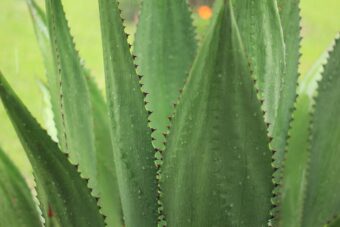
Agave (Agave species) belong to the Asparagus family with 270 species known in South America. The plants are known for their structural beauty. You may think that this big plant cannot be grown in containers but you will be wrong, as in containers you can tailor the growing media to your plant need.
You think that because they come from South America that they are tender but this is not true. Yes, some species cannot take frosts whilst others can take temperatures below the freezing point of water. To be able to do this, you will need to get the drainage right. One thing that must be stressed and you will soon get the point is that the spines are very sharp. You will need to handle them with care with thick gloves, the spines prevent the plant from getting eaten.
THE LEAVES UNFOLD SLOWLY
Agave leaves tend to unfold very slowly and for most of its life, it has a compact, conical shape. Many varieties often have pronounced markings and patterns, so you do have a choice as to what to grow- plain leaves or variegated leaves. So the plant will become a statement plant in your garden.
They do flower but it takes an age to do so. This is why the common name of century plant comes from, as it can take that long to flower. It has been recorded that some varieties take 60 years or so to flower, so do not worry if you have never seen your plant in bloom. If you are lucky enough to see it in flowers, you will never forget it as the flower spikes can grow up to 12m tall.
As agaves do not readily flower crosses and hybrids rarely occur, but if they do beautiful cultivars are produced that are sought after.
If you want to grow a container specimen I suggest that you grow a variegated form.
PLANTING AN AGAVE IN A CONTAINER
First, get a container that is large enough for the plant size in question-a half-barrel is ideal. Make sure whatever container you use has plenty of drainage holes. On top of this, add a 5cm layer of gravel at the bottom. As this will aid drainage even further.
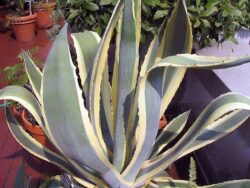
On top of this, add a growing media mix of 50% by volume multiple purpose compost with 50% by volume of horticultural grit to which a handful of slow-release fertilizer has been added. This is essential to make the growing media free-draining and to help to feed the plant through the growing season.
After that, every month during the growing season, you will need to add a well-balanced liquid fertilizer to feed these hungry plants. This will make the plant develop a strong root system.
Dig a hole that is twice the size of the root ball it came in the original container. Place the plant at a slight angle, so that plant’s crown will never become waterlogged. Too much water will cause the roots to rot. Place it in the hole at the same level it came in the original container but with one side higher than the other, Backfill with growing media and fill any gaps with even more growing media. Firm it in and water lightly.
Your plant will be happy in its new home. Once a plant has become root bound, you will need to repot to the next pot size on until you cannot repot further. At this time it is a good idea to remove dying leaves and dead roots, as well as remove and pot up any young plants growing from the mother plant. Always wear gloves whilst doing this, as the spikes are sharp and the sap it produces are irritating.
THEY LIKE THE SUN
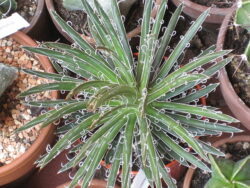
You can situate the Agave in full sun in a sheltered spot, where the cold, hardy varieties will grow happily if you have provided the correct amount of drainage. It is best to elevate the container by using pot feet, as this will help drainage either further. On top of the compost, it is a good idea to add a 1cm layer of horticultural grit to stop the leaves from touching the wet soil and rotting. The variegated varieties prefer partial shade to stop the colours and markings from fading, whilst full green varieties prefer to grow in full sun.
Water when the compost gets dry, which may be once a week in summer, but in a heatwave, you may need to water up to 3 times a week. When watering make sure you water away from the leaves and make sure that the compost is thoroughly drenched, Water in the morning to allow the leaves to dry out and prevent potential root rot.
In winter, you will only need to water when the compost dries out.
OVERWINTERING AGAVES
As said earlier the plants are tough and can deal with everything the British weather throws at them. They can survive heatwaves, storms, torrential downpours and some species have Agave montana have concave leaves.
As winter is the Agave resting period, you will need to offer some protection from the elements, especially the rain and cold. Offer a spot that is sheltered and gets the lightest rain possible.
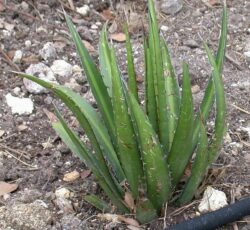
Sunlight is vital in winter. To help the application of horticultural fleece, you can snip the spines off the leaves of the Agave, as this will not hurt the plant at all. Firstly, this will stop the spines from jabbing yourself when covering the plant and secondly, it will stop the fleece from getting ripped. Do not worry as this will not affect the plant in any way but do not cut the leaf tips.
If you are growing a more tender variety like Agave amerciana then you will need to move the pot into a greenhouse, conservatory or inside your own home on a sunny windowsill.
AGAVE PESTS AND DISEASES
As root rot can be a problem it is important that the growing media you use is free-draining as described in this article.
On the pest front, they can be attacked with scale insects that are best dealt with by the use of a suitable systemic insecticide. They can also suffer damage from slugs and snails, so use an application of wool deterrent matting or pellets to keep them in check.
VARIETIES TO GROW
Agave americana has blue-grey foliage that has a zinc white bloom and has a large, upright growing habit.
Agave americana ‘Marginata’ is a variegated century plant and is less hardy than the other varieties, It has deep green leaves that are a lighter green at the edges. It is a wonderful plant.
Agave cupreata (The Dwarf Horn Agave) is a small to medium-sized agave that had broad green obovate leaves that have copper-coloured spines along its wavy margins.
Agave deserti var. deserti (The Desert Agave) produces medium-sized rosettes with elongated, glaucous grey leaves that are thickly fleshed, rigid and notably concaved at the uppermost surface. The rosette is open and radiates from the centre.
OTHER VARIETIES INCLUDE
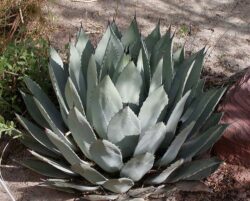
Agave filifera is a compact medium-sized agave with tough green leaves with many attractive curling white threads along their margins and sharp terminal spines. It usually forms a single growing point.
Agave gentryi has a rosette of broad, spiky leaves that are fleshy, bluish-grey whilst young but maturing to a darker green.
Agave horrida var. horrida has a beautiful symmetrical rosette with rigid stubbly oblate leaves that are very attractive glossy green in colour and often have a very pale central stripe. The dark marginal spikes turn a papery white with age.
Agave lechuguilla has thin long leaf blades that are held in an open upright manner that makes it look like a starfish, the leaves have a pale yellowish-green stripe that runs down the middle of each leaf. At the marginals of the leaves, it has a white stripe that contrasts well with the leaves. A rare species to find in the gardens
Agave montana (Mountain Agave) has a symmetrical rosette of dark green leaves that is usually covered with a pale frosting of whitish bloom. On the lower surface the distinctive impressions of the thorny leaf margins.
Agave palmeri forms rosettes and has a very straight and erect growth habit. Typically with long lanceolate leaves that are greyish-green that often tinged with red or purple under stress. On the margins close to the spines it has a stripe of pinkish-red or creamy yellow. It is more compact than other varieties and looks like it is squatting.
CONCLUSIONS
In this article, we have discussed how to grow Agaves in containers. They are not only colourful plants with large attractive leaves that are often variegated. They are hardy than they look and you have plenty of varieties that can be grown.
Agaves tend to be easier to look after, only require watering and feeding when required, they will flower too but this is rarely seen in the home garden but if they do the plant will die. Do not worry as before this happens, it produces offsets that can be planted and grown on. You will have new plants in the near future.
Colourful, elegant plants and plenty of varieties to choose from, so why not grow one today.
If you have any comments or questions that you wish to make on this topic, please do so in the comment box below.
Happy agave growing.
